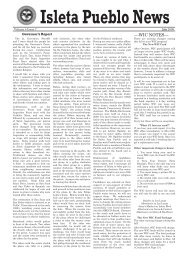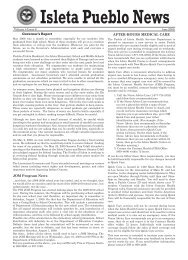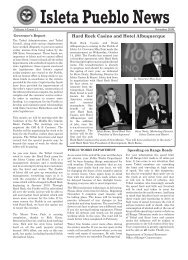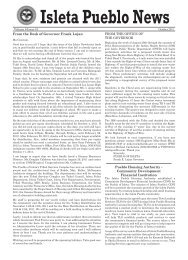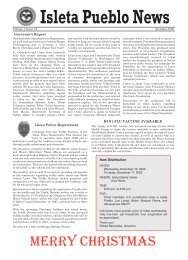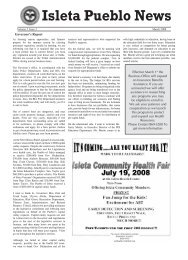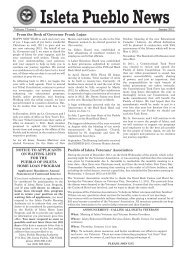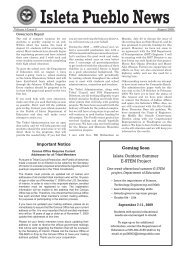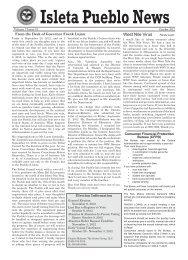From the Desk of Governor Frank Lujan - Isleta Pueblo
From the Desk of Governor Frank Lujan - Isleta Pueblo
From the Desk of Governor Frank Lujan - Isleta Pueblo
You also want an ePaper? Increase the reach of your titles
YUMPU automatically turns print PDFs into web optimized ePapers that Google loves.
November 2012<br />
Head Lice<br />
<strong>Isleta</strong> <strong>Pueblo</strong> News Page 19<br />
Stephanie Barela, Health Educator, 869-4479<br />
What are head lice?<br />
The head louse (singular for lice) is an insect that lives and<br />
reproduces on your head. Head lice (pediculosis) feed <strong>the</strong>mselves<br />
by biting your scalp. Having head lice is common; as many as 6-12<br />
million people in <strong>the</strong> word get head lice each year.<br />
Who gets head lice?<br />
Anyone who comes in close head-to-head contact with someone who<br />
already has head lice can get head lice. Head lice are found more<br />
<strong>of</strong>ten among children between 3-10 years <strong>of</strong> age and <strong>the</strong>ir families.<br />
More <strong>of</strong>ten <strong>the</strong>y are found in females than males.<br />
How do I get head lice?<br />
• By close head-to-head contact with someone who already<br />
has had lice. Contact is common during play at school and at<br />
home (slumber parties, sports activities, at camp, on <strong>the</strong> play<br />
ground, etc.)<br />
• By using hats, scarves, combs, brushes, hair ribbons, pillows<br />
or towels recently used by someone with head lice.<br />
What do <strong>the</strong>y look like?<br />
The insects are tiny, wingless, move quickly and are difficult to<br />
see. They cannot jump or fly. They are 1-2 mm long and greyish<br />
brown in color. There are three forms <strong>of</strong> lice: <strong>the</strong> nit, <strong>the</strong> nymph<br />
and <strong>the</strong> adult.<br />
• Nits: Nits are head lice eggs. They are hard to see and<br />
are <strong>of</strong>ten confused with dandruff or hairspray droplets. Nits<br />
are found firmly attached to <strong>the</strong> hair shaft. They are oval and<br />
usually yellow to white. Nits take about one week to hatch.<br />
• Nymph: The nit hatches into a baby louse called a nymph. It<br />
looks like an adult head louse, but is smaller. Nymphs mature<br />
into adults about seven days after hatching. To live, <strong>the</strong> nymph<br />
must feed on human blood.<br />
• Adults: The adult louse is about <strong>the</strong> size <strong>of</strong> a sesame seed,<br />
has six legs and is tan to greyish-white. Females lay nits; <strong>the</strong>y<br />
are usually larger than males. Adult lice can live up to 30 days<br />
on a person's head. To live, adult lice need to feed on human<br />
blood. If a louse falls <strong>of</strong>f a person, it dies within two days.<br />
How are head lice treated?<br />
• Over <strong>the</strong> Counter Medications:<br />
• Pyrethrins (RID)<br />
• Permethrin(Nix) (<strong>Isleta</strong> Pharmacy <strong>of</strong>fers)<br />
• Apply <strong>the</strong> product following instructions carefully. Misuse<br />
and overuse could be hazardous.<br />
• Remove nits by combing <strong>the</strong> hair with special nit comb.<br />
• Part <strong>the</strong> hair in 4 sections and work on one section at a<br />
time.<br />
• Start at <strong>the</strong> top <strong>of</strong> <strong>the</strong> head, with one hand lift a 1-2 inch<br />
wide strand <strong>of</strong> hair. Get <strong>the</strong> teeth <strong>of</strong> <strong>the</strong> comb as close to <strong>the</strong><br />
scalp as possible and comb with a firm, even motion away from<br />
<strong>the</strong> scalp to <strong>the</strong> end <strong>of</strong> <strong>the</strong> hair.<br />
• Use clips to pin back each strand <strong>of</strong> hair after you have<br />
combed out <strong>the</strong> nits<br />
• Clean <strong>the</strong> comb completely as you go. Wipe <strong>the</strong> nits from<br />
<strong>the</strong> comb with a tissue and throw away <strong>the</strong> tissue in a sealed<br />
plastic bag to prevent <strong>the</strong> lice from coming back.<br />
• After combing, carefully check all sections <strong>of</strong> <strong>the</strong> head and<br />
remove all <strong>the</strong> nits by using fingernails or a nit comb to drag<br />
each nit down <strong>the</strong> hair shaft.<br />
• Check <strong>the</strong> head for live lice daily between treatments and<br />
remove any nits that are still present. Use a bright light to<br />
help you see. If live lice are found in <strong>the</strong> days following <strong>the</strong> first<br />
treatment, consult your doctor.<br />
Do I need to clean my house?<br />
• Must wash hats, scarves, hairbrushes, combs, or any o<strong>the</strong>r<br />
item that is worn or used on <strong>the</strong> head, as well as, pillow cases,<br />
towels, bed linens after <strong>the</strong> first and second treatment in very<br />
hot soapy water.<br />
• Items that cannot be machine washed should be dry cleaned<br />
or placed in an airtight bag for 10 days to 2 weeks.<br />
• Excessive house cleaning is not necessary, but it may be<br />
advisable to vacuum surfaces where heads have rested (s<strong>of</strong>as,<br />
car seats and helmets). Never use insecticide sprays.<br />
How can I control <strong>the</strong> spread <strong>of</strong> head lice?<br />
• Discourage head-to-head contact and sharing <strong>of</strong> hats,<br />
scarves, hairbrushes and combs.<br />
• Tie long hair back in braids.<br />
• Check <strong>the</strong> hair <strong>of</strong> all family members and people in close<br />
contact in case someone else has head lice.<br />
• All family members with head lice should be treated at <strong>the</strong><br />
same time.<br />
• Tell all close contacts <strong>of</strong> <strong>the</strong> person with head lice to check<br />
<strong>the</strong>ir head. As well, tell <strong>the</strong> child's teacher and/or daycare<br />
provider.<br />
• You cannot prevent head lice by using head lice shampoos<br />
or products—use <strong>the</strong>m ONLY if you have head lice.<br />
• Check young school age children weekly for head lice; more<br />
<strong>of</strong>ten if <strong>the</strong>re is an outbreak.<br />
FOR MORE INFORMATION CALL THE ISLETA HEALTH<br />
CENTER COMMUNITY HEALTH NURSES (505-869-4864<br />
OR 505-869-4873)<br />
Adapted from Toronto Public Health Oct 2012<br />
HEALTH BEAT<br />
Talk to your Kids Early about<br />
Hazards <strong>of</strong> Smoking<br />
<strong>Isleta</strong> Health Center, Health Educator:<br />
Stephanie Barela 869-4479<br />
"Talk to Children Early About Hazards <strong>of</strong> Smoking, New Mexico<br />
Market Place June 2012"<br />
Our children are influenced by many things. Some influences are<br />
good and unfortunately some are bad. These bad influences can<br />
"keep are children from growing up to <strong>the</strong>ir healthiest potential".<br />
One way to protect your child from <strong>the</strong>se influences is by giving<br />
<strong>the</strong>m <strong>the</strong> proper knowledge. Educate your children early about<br />
<strong>the</strong> dangers caused from smoking. The youth smoking prevention<br />
program, (www.RealParentsRealAnswers.com)", is designed to<br />
encourage parents to talk with <strong>the</strong>ir children about not smoking.<br />
The site has interactive videos, quizzes and plenty <strong>of</strong> educational<br />
background information for parents. Some tips to help get <strong>the</strong><br />
conversations started include:<br />
• Sit down with your child and ask <strong>the</strong>m what <strong>the</strong>y know<br />
about cigarettes. Ask your child to participate, and share,<br />
so she doesn't feel like you are lecturing to her. Answer <strong>the</strong><br />
questions honestly, and if you don't know an answer, do some<br />
research toge<strong>the</strong>r.<br />
• Express feelings with your child and ask <strong>the</strong>m what <strong>the</strong>y<br />
know about cigarettes. Let <strong>the</strong>m know what it is about addictive<br />
behaviors that scared you. You may also want to share your<br />
personal history to help understand any challenges you may<br />
have overcome.<br />
• Discuss <strong>the</strong> o<strong>the</strong>r facets <strong>of</strong> smoking, like costs, smell and<br />
even how repeated smoking can change physical appearances.<br />
• Come up with ideas on how your child can respond to <strong>the</strong><br />
question "Want to try a cigarette?" Let your child use <strong>the</strong>ir own<br />
personality to develop <strong>the</strong> answer in different ways so <strong>the</strong>y are<br />
comfortable saying "no" in <strong>the</strong>ir own way.<br />
Educate your child on <strong>the</strong> difference between commercial and<br />
traditional tobacco. Ask your child to take <strong>the</strong> "Tobacco-Free<br />
Me" pledge. If you go onto <strong>the</strong> website mentioned above (www.<br />
RealParentsRealAnswers.com), you can print out a certificate<br />
if your child takes <strong>the</strong> Tobacco-Free Me Pledge. Then post <strong>the</strong><br />
certificate in sight, as a reminder to your child that <strong>the</strong>y have<br />
pledged to stay healthy. If your child does take this pledge, <strong>the</strong>y<br />
will receive free gifts, like a back pack pin or a car magnet.<br />
Lastly, you can contact me, <strong>the</strong> <strong>Isleta</strong> Health Center Health<br />
Educator, at 505-869-4479 and I can <strong>of</strong>fer you more information<br />
and incentives to give your child as away to promote healthy<br />
living.



